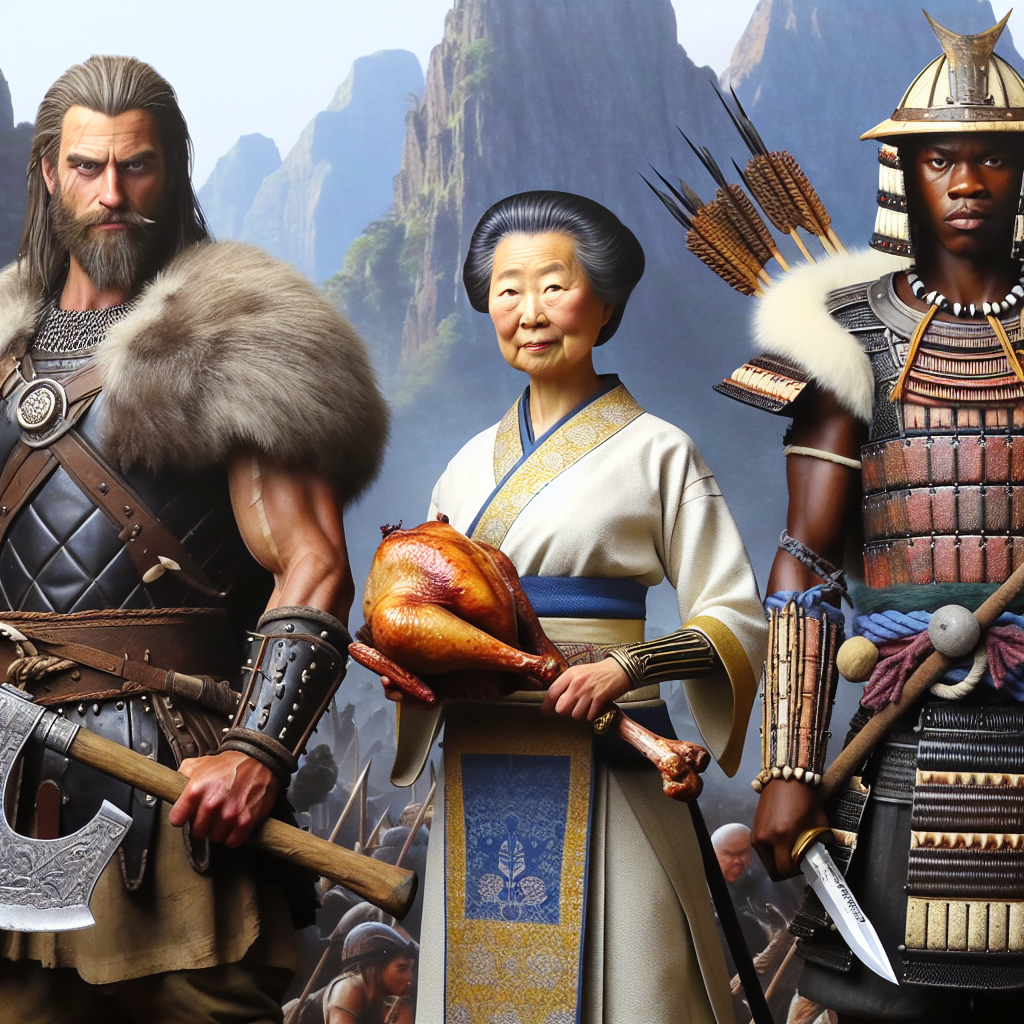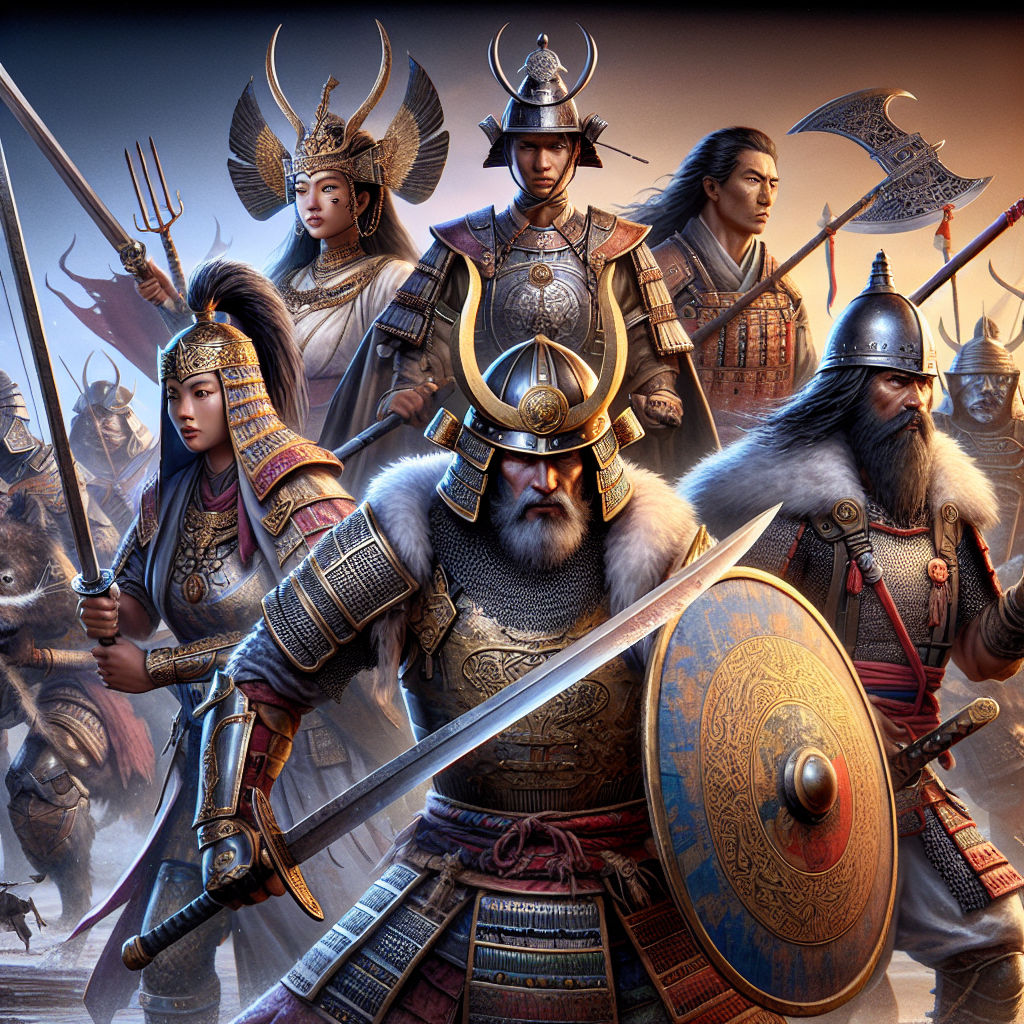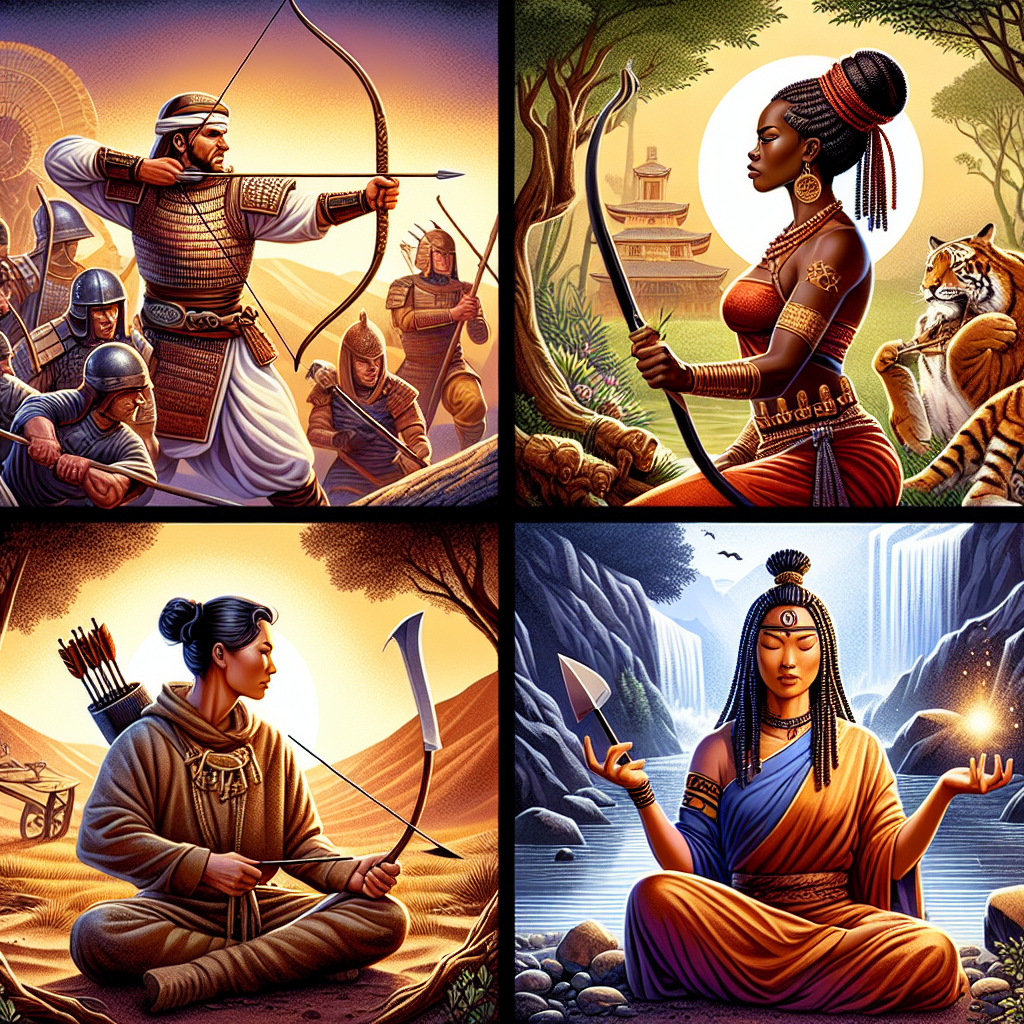Throughout history, there have been countless warriors who have become legendary for their exceptional courage, skill, and strength on the battlefield. From the valiant Knights of the Round Table to the fearsome Samurai warriors of ancient Japan, these individuals have left an indelible mark on our collective consciousness. In this exploration, we will delve into the lives and deeds of some of history’s most extraordinary fighters, uncovering the stories of their triumphs and struggles, their victories and defeats. Join us as we embark on a journey through time, unraveling the myths and uncovering the truths behind these iconic figures who have captured our imaginations for generations kitchen drawer organizer.
The Origins of Legendary Warriors

– Early Civilizations and the Rise of Warrior Cultures
Warfare has been an intrinsic part of human history since the dawn of civilization. In the ancient world, early civilizations such as the Mesopotamians, Egyptians, Greeks, and Romans all had distinct warrior cultures that revered martial prowess and valor on the battlefield. These societies often glorified their warriors through epic tales and heroic myths, elevating them to legendary status in the eyes of their people.
The Mesopotamians, for example, celebrated their warrior-kings like Gilgamesh, a legendary figure whose epic exploits were immortalized in the “Epic of Gilgamesh.” Similarly, the Greeks honored heroes like Achilles and Hercules, whose feats of strength and bravery became the stuff of legend. These early civilizations laid the foundation for the development of legendary warriors, whose stories would be passed down through generations, shaping the collective memory of their respective societies.
- Influence of Mythology and Folklore on Legendary Warrior Figures
Mythology and folklore played a significant role in shaping the image of legendary warriors throughout history. These tales often blurred the lines between reality and fiction, embellishing the exploits of warriors to larger-than-life proportions. In many cultures, legendary warriors were depicted as demigods or supernatural beings, endowed with extraordinary abilities and destined for greatness.
For instance, Norse mythology is replete with legendary warriors like Odin, Thor, and Loki, who embodied the ideals of courage, strength, and cunning. These figures became symbols of heroism and valor, inspiring generations of warriors to emulate their deeds in battle. Similarly, in Japanese folklore, samurai warriors were often portrayed as noble and virtuous warriors, guided by a strict code of honor known as Bushido.
Overall, the influence of mythology and folklore served to elevate legendary warriors to mythical status, transforming them from mere mortals into immortalized icons of courage and resilience.
Notable Figures in Ancient History
The Origins of Legendary Warriors
- Spartans: The fierce warriors of ancient Greece
The Spartans, known for their militaristic society, were revered for their unparalleled discipline and prowess in battle. Trained from a young age in combat and warfare, these warriors were a formidable force on the battlefield. Their most famous stand was at the Battle of Thermopylae, where King Leonidas and his 300 Spartans faced overwhelming odds against the Persian army. - Samurai: The disciplined warriors of feudal Japan
The Samurai, often depicted as noble and skilled warriors, were a prominent military caste in feudal Japan. They adhered to a strict code of honor known as Bushido, emphasizing loyalty, self-discipline, and martial prowess. Samurai were trained in various combat techniques, including swordsmanship and archery. Their unwavering dedication to their lords and commitment to their code made them legendary figures in Japanese history. - Vikings: The fearless seafaring warriors of Scandinavia
The Vikings, renowned for their fearless spirit and seafaring abilities, were fierce warriors from Scandinavia who raided and explored vast territories during the Viking Age. These warriors were skilled in navigation, shipbuilding, and combat, making them formidable opponents in battle. Known for their ferocity and plundering raids, the Vikings left a lasting impact on the regions they traversed, earning a reputation as both fearsome warriors and intrepid explorers.

The Art of War: Legendary Warrior Strategies
Tactical Brilliance of Legendary Warriors on the Battlefield
Legendary warriors throughout history have demonstrated exceptional tactical brilliance on the battlefield, showcasing their ability to outmaneuver and outthink their opponents. From the strategic genius of Alexander the Great, who employed the “hammer and anvil” tactic to crush his enemies, to the cunning maneuvers of Sun Tzu, whose principles of deception and misdirection are still studied today, these warriors utilized a combination of skill, experience, and intuition to achieve victory in the face of overwhelming odds.
Adaptability and Innovation in Warfare Techniques
One of the key characteristics that set legendary warriors apart was their ability to adapt to changing circumstances and innovate new warfare techniques. For example, the Mongol warriors under the leadership of Genghis Khan revolutionized the use of mounted archery, allowing them to swiftly conquer vast territories and establish one of the largest empires in history. Similarly, the Samurai of feudal Japan honed their skills in swordsmanship and bushido code, blending tradition with innovation to become formidable warriors on the battlefield. These warriors were not bound by convention but instead constantly sought new ways to gain the upper hand in combat, ensuring their place in history as legendary figures in the art of war.
Sun Tzu: The Master Strategist
Art of War: Legendary Warrior Strategies
- The enduring legacy of “The Art of War”
Sun Tzu’s timeless masterpiece, “The Art of War,” continues to captivate scholars and military leaders alike with its profound insights into the nature of warfare. Written over two millennia ago, this ancient text remains a cornerstone of strategic thinking, offering invaluable lessons on tactics, leadership, and the art of victory.
- Influence on military tactics and leadership
Sun Tzu’s teachings have had a profound impact on military strategies throughout history. His emphasis on the importance of intelligence gathering, adaptability, and psychological warfare has shaped the way generals approach conflict. Leaders across the centuries have drawn inspiration from Sun Tzu’s emphasis on outthinking the enemy rather than relying solely on brute force. The principles laid out in “The Art of War” continue to inform modern military doctrine, highlighting the enduring relevance of Sun Tzu’s wisdom.
Genghis Khan: The Conqueror of Empires
Genghis Khan, the renowned Mongol leader, is hailed as one of history’s most legendary warriors due to his unparalleled military conquests and strategic brilliance. With a keen understanding of warfare tactics, Khan expanded the Mongol Empire through a series of calculated and ruthless campaigns.
Unprecedented Military Conquests
Genghis Khan’s military campaigns were marked by their sheer scale and ferocity. He led his armies to victory against formidable opponents, including the powerful Jin Dynasty in China and the Khwarezmian Empire in Central Asia. Khan’s ability to mobilize and coordinate his troops effectively allowed him to conquer vast territories and establish the largest contiguous empire in history.
Organization and Discipline in the Mongol Army

Central to Genghis Khan’s success was the strict organization and discipline he instilled in the Mongol army. He implemented a hierarchical command structure that ensured orders were followed swiftly and efficiently on the battlefield. Khan also promoted meritocracy within his ranks, rewarding skill and loyalty regardless of social status. This approach fostered a sense of unity and cohesion among his troops, enabling them to execute complex military maneuvers with precision.
Myth vs. Reality: Debunking Warrior Legends
Separating fact from fiction in the stories of legendary warriors
In the realm of historical accounts of legendary warriors, it is imperative to discern between fact and fiction. Many tales of renowned fighters have been embellished over time, blurring the lines between reality and myth. By scrutinizing primary sources and archaeological evidence, researchers can sift through the layers of embellishment to uncover the true essence of these legendary figures.
Historical inaccuracies and embellishments in warrior tales
The retelling of warrior legends often involves a degree of romanticization and exaggeration. Accounts of battles fought and conquests achieved are frequently embellished to elevate the heroism and prowess of these warriors. However, upon closer examination, discrepancies and inconsistencies emerge, shedding light on the historical inaccuracies that have woven themselves into the fabric of these tales. By critically analyzing these narratives, historians can peel away the layers of myth to reveal a more nuanced and authentic portrayal of history’s most legendary warriors.
Joan of Arc: The Maid of Orleans
Joan of Arc, often referred to as the Maid of Orleans, is a legendary figure known for her remarkable military achievements during the Hundred Years’ War between France and England. Despite her young age and lack of formal military training, Joan played a crucial role in turning the tide of the war in favor of the French.
- Examining the truth behind Joan of Arc’s military feats:
Joan’s military feats, including lifting the siege of Orleans and leading the French to several key victories, have been the subject of much debate among historians. While some argue that her success was due to divine intervention or supernatural abilities, others point to her strategic acumen and leadership skills. - Political and religious motivations behind her legend:
Joan’s legend is intricately tied to the political and religious context of her time. She claimed to have received visions from saints instructing her to support Charles VII’s claim to the French throne. Her unwavering faith and belief in her divine mission inspired troops and rallied support for the French cause.
Joan of Arc’s legacy continues to captivate historians and enthusiasts alike, highlighting the intersection of faith, politics, and warfare in shaping historical narratives.
Achilles: The Hero of the Trojan War
- Analyzing the mythical aspects of Achilles’ story
Achilles, the Greek hero of the Trojan War, is often depicted as invincible due to his mother dipping him in the River Styx as an infant, making him immune to harm except for his heel. This mythological element adds a layer of mystique to his character, portraying him as an almost god-like figure on the battlefield. However, it is essential to separate the myth from reality when examining Achilles’ true prowess as a warrior.
- Historical context of the Trojan War and Achilles’ role
The Trojan War, a significant event in Greek mythology, was fought between the Greeks and the Trojans over the abduction of Helen, the wife of Menelaus, by Paris of Troy. Achilles played a crucial role in this epic conflict, known for his unparalleled combat skills and fierce determination. His presence on the battlefield was feared by the Trojans, as he was instrumental in turning the tide of many battles in favor of the Greeks. Despite his heroic status, Achilles also faced moments of vulnerability and inner conflict, adding depth to his character beyond mere physical strength.
Legacy of Legendary Warriors
Legendary warriors have left an indelible mark on culture and society, shaping perceptions of heroism, courage, and strength for generations to come. Their feats in battle and tales of valor have become intertwined with the very fabric of history, inspiring awe and admiration.
Impact of legendary warriors on culture and society
- Role models for courage and bravery: Legendary warriors serve as exemplars of valor, inspiring individuals to rise above adversity and face challenges with unwavering determination.
- Symbol of power and strength: These warriors embody the pinnacle of physical and mental prowess, symbolizing the triumph of human spirit over insurmountable odds.
- Cultural icons: Their stories are woven into the cultural tapestry of societies, becoming symbols of national pride and identity.
- Influence on warfare tactics: The strategies and tactics employed by legendary warriors have often influenced military doctrines and warfare techniques for centuries.
Perpetuation of warrior myths through literature and media
- Literary works: Epic poems, sagas, and chronicles immortalize the deeds of legendary warriors, ensuring their legacy endures through the written word.
- Film and television: The portrayal of legendary warriors in movies and TV shows brings their stories to life, captivating audiences and keeping their legends alive in the modern era.
- Artistic representations: Paintings, sculptures, and other forms of art depict legendary warriors in heroic poses, further cementing their place in history and popular imagination.
- Pop culture references: From video games to comic books, references to legendary warriors abound in popular culture, ensuring their stories remain relevant and impactful in contemporary society.
Musashi Miyamoto: The Sword Saint
Musashi Miyamoto, a legendary samurai warrior from Japan, is renowned for his exceptional skill in swordsmanship and his profound impact on Japanese martial arts and philosophy. Born in 1584, Musashi’s legacy is rooted in his unorthodox fighting style and his undefeated record in over 60 duels. He is best known for his innovative two-sword technique, known as Niten Ichi-ryu, which involved wielding both a katana and a wakizashi simultaneously.
Musashi’s teachings emphasized the importance of adaptability, strategy, and mindfulness in combat, which have influenced generations of martial artists. His philosophical treatise, “The Book of Five Rings,” remains a classic text on strategy and warfare, offering insights into the mindset and tactics of a master warrior.
In popular culture, Musashi has been immortalized in various forms, including films, novels, and video games. His stoic demeanor, unmatched skill in combat, and unwavering commitment to his principles have solidified his status as a symbol of honor and martial prowess in Japanese history and beyond.
William Wallace: The Scottish Freedom Fighter
William Wallace, known as a symbol of Scottish resistance against English domination, left a profound mark on history with his courageous efforts to free Scotland from oppressive rule. His legacy continues to resonate through the annals of time, inspiring generations of Scots to stand up for their independence.
Historical Significance of William Wallace’s Resistance against English Rule
- Wallace’s defiance against the English began in the late 13th century, during a tumultuous period when Scotland faced brutal subjugation under English monarchs.
- Leading a series of successful military campaigns, Wallace inflicted significant blows on the English forces, showcasing his tactical prowess and unwavering determination.
- The Battle of Stirling Bridge in 1297 stands out as a defining moment in Wallace’s legacy, where his outnumbered Scottish army secured a remarkable victory against the English oppressors.
Evolution of Wallace’s Legend in Scottish National Identity
- Over time, Wallace’s exploits were immortalized through oral traditions and later written accounts, transforming him into a legendary figure in Scottish folklore.
- His portrayal as a valiant hero in literature and popular culture solidified his status as a symbol of Scottish pride and resilience.
- The iconic portrayal of Wallace in the film “Braveheart” further cemented his place in the hearts of Scots worldwide, perpetuating his legend for future generations to admire and draw inspiration from.
FAQs: Unveiling the Legends: A Closer Look at History’s Most Legendary Warriors
Who were some of the most legendary warriors in history?
Some of the most legendary warriors in history include figures like Alexander the Great, Genghis Khan, Joan of Arc, and Samurai warriors like Miyamoto Musashi and Oda Nobunaga. These individuals were known for their strategic brilliance, fearless combat skills, and leadership qualities that left a lasting impact on history.
What made these warriors so legendary?
These legendary warriors were known for their exceptional military tactics, leadership abilities, and unparalleled combat skills that allowed them to achieve incredible feats on the battlefield. They often led their armies to victory in challenging and iconic battles, solidifying their place in history as some of the greatest warriors of all time.
How did legendary warriors influence history?
Legendary warriors played a significant role in shaping the course of history through their conquests, military campaigns, and leadership during pivotal moments in time. Their actions often determined the outcomes of major conflicts, expanded empires, and established new dynasties, leaving a lasting legacy that continues to be studied and revered today.
What lessons can we learn from the legendary warriors of history?
The legendary warriors of history can teach us valuable lessons about courage, determination, strategic thinking, and the importance of strong leadership. Their stories serve as inspiration for overcoming adversity, facing challenges head-on, and striving for greatness in all areas of life. By studying their tactics and approaches to warfare, we can gain insights that are applicable to various aspects of modern society.
0 Comments